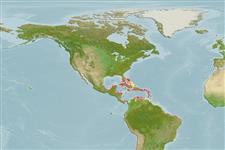>
Blenniiformes (Blennies) >
Labrisomidae (Labrisomids)
Etymology: Paraclinus: Greek, para = the side of + Greek, klinein, kline = sloping and bed, due to the four apophyses of sphenoid bone (Ref. 45335).
More on author: Steindachner.
Environment: milieu / climate zone / depth range / distribution range
Ecología
marino asociado a arrecife; rango de profundidad 0 - 2 m (Ref. 9710). Tropical; 33°N - 6°N, 99°W - 58°W
Western Atlantic: Florida, USA and the Bahamas (including northern Gulf of Mexico) to Central and northern South America.
Tamaño / Peso / Age
Maturity: Lm ? range ? - ? cm
Max length : 6.5 cm TL macho / no sexado; (Ref. 7251)
Short description
Morfología | Morfometría
Espinas dorsales (total): 29 - 32; Radios blandos dorsales (total): 0; Espinas anales 2; Radios blandos anales: 18 - 20. Color varies from uniform dark brown to light brown with dark bars (Ref. 13442).
Occurs in protected shallow waters, in coral, rock or sand bottoms (Ref. 5521) especially in seagrass beds (Ref. 7251).
Carnivorous; diet may vary according to seasonal and spatial changes in prey species abundance. Preys on a few species of amphipods as juveniles and shift to diet of crabs, shrimp and isopods (Ref. 94105).
Life cycle and mating behavior
Madurez | Reproducción | Puesta | Huevos | Fecundidad | Larva
Robins, C.R. and G.C. Ray, 1986. A field guide to Atlantic coast fishes of North America. Houghton Mifflin Company, Boston, U.S.A. 354 p. (Ref. 7251)
IUCN Red List Status (Ref. 130435)
Threat to humans
Harmless
Human uses
Más información
Nombres comunesSinónimosMetabolismoDespredadoresEcotoxicologíaReproducciónMadurezPuestaAgregación para la puestaFecundidadHuevosEgg development
ReferenciasAcuiculturaPerfil de acuiculturaRazasGenéticaElectrophoresesheritabilidadEnfermedadesProcesamientoNutrientsMass conversion
ColaboradoresImágenesStamps, Coins Misc.SonidosCiguateraVelocidadTipo de nataciónSuperficie branquialOtolitosCerebrosVisión
Herramientas
Special reports
Download XML
Fuentes de Internet
Estimates based on models
Preferred temperature (Ref.
123201): 26.1 - 28.2, mean 27.4 °C (based on 429 cells).
Phylogenetic diversity index (Ref.
82804): PD
50 = 0.5000 [Uniqueness, from 0.5 = low to 2.0 = high].
Bayesian length-weight: a=0.00813 (0.00388 - 0.01704), b=3.03 (2.84 - 3.22), in cm total length, based on LWR estimates for this species & (Sub)family-body (Ref.
93245).
Nivel trófico (Ref.
69278): 3.5 ±0.4 se; based on size and trophs of closest relatives
Fishing Vulnerability (Ref.
59153): Low vulnerability (10 of 100).
Nutrients (Ref.
124155): Calcium = 155 [78, 317] mg/100g; Iron = 0.85 [0.45, 1.54] mg/100g; Protein = 18.9 [17.6, 20.0] %; Omega3 = 0.131 [0.069, 0.249] g/100g; Selenium = 11.4 [5.0, 26.5] μg/100g; VitaminA = 248 [68, 919] μg/100g; Zinc = 2.43 [1.53, 3.69] mg/100g (wet weight);
